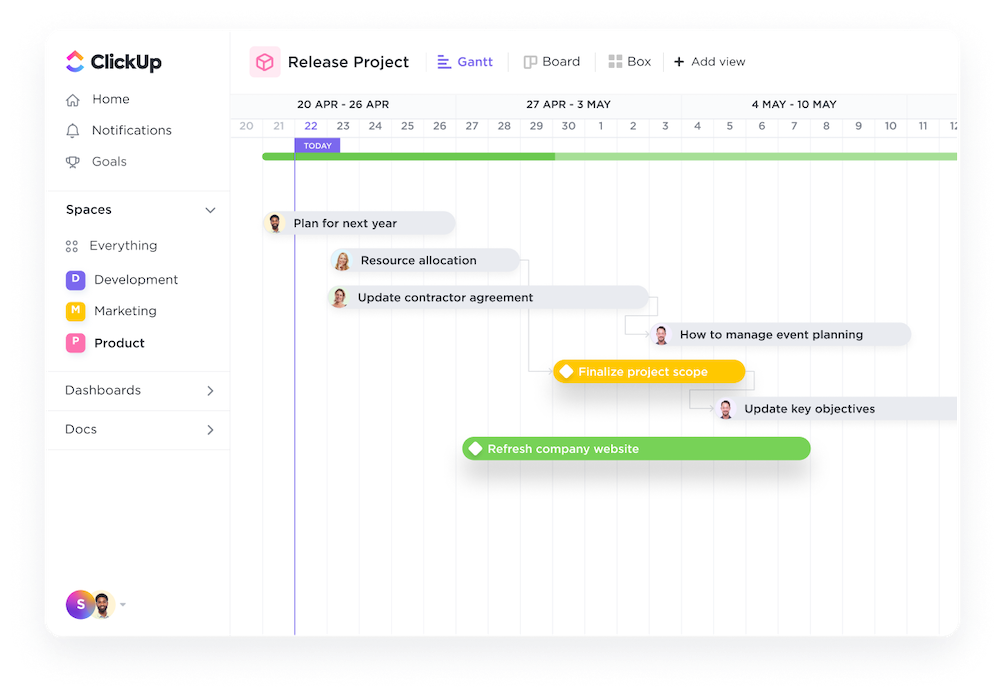Key takeaways
What is a project milestone?
A project milestone is a strategic point in a project’s timeline when a certain subtask, event, phase, or goal is completed. Whether you’re operating a short-term or long-term project, incorporating milestones is an effective way to manage how time and resources are spent.
Here’s a quick breakdown of how project milestones differ from other key project management terms:
- Milestone vs. task: A milestone is a trackable sub-goal that’s composed of more granular tasks and sub-tasks.
- Milestone vs. deliverable: While a deliverable is a specific goal or outcome that the project team hopes to achieve, a milestone is typically the achievement of one or multiple of these deliverables.
- Milestone vs. KPI: Key performance indicators (KPIs) measure performance across multiple metrics throughout a project, whereas milestones represent achievements at specific points in the project. KPIs are often used to analyze progress toward milestones.
Project milestones are typically set jointly by the project team’s leader and key decision-maker(s). They should be specific, measurable, and strategically timed throughout a project’s lifecycle.
Benefits of milestones in project management
While setting project milestones can feel like an arduous task, many benefits come from breaking down your projects with milestones in mind:
- Clearer project phases and improved task prioritization: Especially for long-term projects, it can be difficult to decide what’s important now and what will be important later. Setting milestones helps all team members prioritize the current tasks on their plates so they can more effectively move on when it’s time rather than multitasking.
- Built-in pauses and pivot points: Milestones give teams a chance to reflect on what is and isn’t working so far. With this pause, both the project team and the client can evaluate if changes are needed while also identifying new risks that need to be mitigated in the next project phase.
- Clearly defined roles and responsibilities: Milestones and the tasks underneath them often have owners who are responsible for their success. With this organizational structure, it will be clear who is working on what and give teammates the chance to more effectively communicate and collaborate because they are familiar with each other’s workloads.
- Regular progress reports for stakeholders: Progress toward milestones can be tracked in multiple ways, including through visual reports and dashboards. These quantitative illustrations can be shown to clients and other stakeholders who want to see results regularly.
- Improved budget, resource, and timeline management: Milestones help project managers plan every detail, focus on what’s most important, and assign their resources accordingly. Depending on what milestone is next on the list, the project manager can determine how much of their budget and other resources should be used or saved for a later milestone that needs those resources more.
- Boosted project team morale: Each time an important project milestone is achieved will feel like a big win for your team. Setting up milestones is an effective way to give project teams something to look forward to and celebrate at regular intervals, rather than waiting to celebrate until the very end of a project.
How to use project milestones effectively
Project milestones are most helpful when they are set strategically and reviewed periodically. To determine project milestones that help your team more clearly visualize and reach their goals, follow these best practices and tips:
Set clear milestones from the start
Similar to SMART goals, your project milestones should be specific, measurable, achievable, relevant, and timely. The most important part of this equation is timeliness: When should this milestone be completed in relation to other milestones and the project at large? Additionally, what tasks, resources, and team members need to align with this milestone for it to be a success? Answering these questions from the beginning of your process will help you create milestones that successfully showcase progress toward project deliverables and goals.
Distribute strategic milestones throughout the project lifecycle
Milestones should not only fall at the beginning and end of the project but also at multiple points during the project. Any time a specific task or goal needs to be completed by a certain date or for future tasks to get underway, look for ways to frame that work as a measurable milestone. This will segment your project into more focused and thoughtful sections and give both your clients and project team members more motivators to get to the next project phase quickly.
Collaboratively set and communicate milestones with key stakeholders
Project teams and clients bring unique perspectives and expertise to each project, so it’s important for both sides to co-create project milestones. This ensures transparency and alignment and also allows both teams to push back where resourcing, budgets, or internal skills may become an issue.
Once milestones have been set, the project manager or the owners responsible for individual milestones should clearly and frequently communicate about progress toward and challenges surrounding milestones. This will help both organizations prepare for best- and worst-case scenarios where milestones may need to be altered.
Use project management tools
Many project management platforms include milestone management features, templates, reports, dashboards, and other resources that can help project teams get organized and more effectively time their milestones. Some of the best project management tools for milestone tracking include Asana, ClickUp, monday work management, Smartsheet, and Wrike.
Adjust milestones as necessary
It’s rare that the initial milestones you set will encompass every change and issue that arises during the course of the project. That’s why project managers need to be agile, vigilant watchers of project performance data, KPIs, and any changes that happen within the internal team or on the client side. Noticing these changes before they become bigger issues is an important first step in communicating the need for and setting new milestones.
Project milestone examples
While this is not an exhaustive list, the following project milestone examples are often used to track project progress:
Start or end date of a project phase
Example: The project team has completed the discovery phase or solution verification period of pre-project research and planning. They have documented their plans through a project charter and received approval from the client to move forward with the actual project. This approval, illustrated in the Asana Gantt chart below, marks the achievement of their first project milestone.

Completion of an initial product or key deliverable
Example: A digital marketing and design agency is helping a client rebrand in the new year. One of the milestones within that rebrand plan is to complete a refresh of the company’s web content, layout, and design. A project management tool like ClickUp helps users visualize the difference between this milestone and related tasks more easily with the Gantt chart layout.

Successful completion of user training
Example: A consulting firm is helping a small business set up a CRM solution that aligns with their customer data and outreach goals. Now that the software has been deployed, is integrated with their systems, and holds all of their relevant data, the project team must train the client’s marketing and sales teams on how to use the software. Achievement of the user training milestone may be determined by a skills test, a survey of trainees, or the completion of a specific training program.





